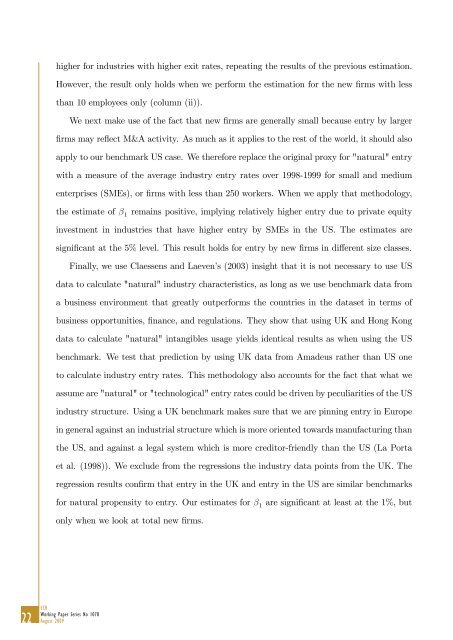On the real effects of private equity investment: evidence from new ...
On the real effects of private equity investment: evidence from new ...
On the real effects of private equity investment: evidence from new ...
- No tags were found...
You also want an ePaper? Increase the reach of your titles
YUMPU automatically turns print PDFs into web optimized ePapers that Google loves.
higher for industries with higher exit rates, repeating <strong>the</strong> results <strong>of</strong> <strong>the</strong> previous estimation.However, <strong>the</strong> result only holds when we perform <strong>the</strong> estimation for <strong>the</strong> <strong>new</strong> …rms with lessthan 10 employees only (column (ii)).We next make use <strong>of</strong> <strong>the</strong> fact that <strong>new</strong> …rms are generally small because entry by larger…rms may re‡ect M&A activity. As much as it applies to <strong>the</strong> rest <strong>of</strong> <strong>the</strong> world, it should alsoapply to our benchmark US case. We <strong>the</strong>refore replace <strong>the</strong> original proxy for "natural" entrywith a measure <strong>of</strong> <strong>the</strong> average industry entry rates over 1998-1999 for small and mediumenterprises (SMEs), or …rms with less than 250 workers. When we apply that methodology,<strong>the</strong> estimate <strong>of</strong> 1 remains positive, implying relatively higher entry due to <strong>private</strong> <strong>equity</strong><strong>investment</strong> in industries that have higher entry by SMEs in <strong>the</strong> US. The estimates aresigni…cant at <strong>the</strong> 5% level. This result holds for entry by <strong>new</strong> …rms in di¤erent size classes.Finally, we use Claessens and Laeven’s (2003) insight that it is not necessary to use USdata to calculate "natural" industry characteristics, as long as we use benchmark data <strong>from</strong>a business environment that greatly outperforms <strong>the</strong> countries in <strong>the</strong> dataset in terms <strong>of</strong>business opportunities, …nance, and regulations. They show that using UK and Hong Kongdata to calculate "natural" intangibles usage yields identical results as when using <strong>the</strong> USbenchmark. We test that prediction by using UK data <strong>from</strong> Amadeus ra<strong>the</strong>r than US oneto calculate industry entry rates. This methodology also accounts for <strong>the</strong> fact that what weassume are "natural" or "technological" entry rates could be driven by peculiarities <strong>of</strong> <strong>the</strong> USindustry structure. Using a UK benchmark makes sure that we are pinning entry in Europein general against an industrial structure which is more oriented towards manufacturing than<strong>the</strong> US, and against a legal system which is more creditor-friendly than <strong>the</strong> US (La Portaet al. (1998)). We exclude <strong>from</strong> <strong>the</strong> regressions <strong>the</strong> industry data points <strong>from</strong> <strong>the</strong> UK. Theregression results con…rm that entry in <strong>the</strong> UK and entry in <strong>the</strong> US are similar benchmarksfor natural propensity to entry. Our estimates for 1 are signi…cant at least at <strong>the</strong> 1%, butonly when we look at total <strong>new</strong> …rms.22 ECBWorking Paper Series No 1078August 2009















